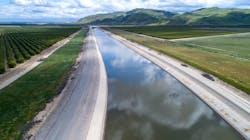Calif. reduces State Water Project allocations
The California Department of Water Resources (DWR) has announced it must reduce the State Water Project allocation to 5 percent of requested supplies for 2022.
DWR previously set the allocation at 15 percent — but the department says that a historically dry January and February, with no significant storms forecast for March, required a reduction in the allocation to conserve available water supply.
In addition to the 5 percent allocation, DWR will also provide any unmet critical health and safety needs of the 29 water agencies that contract to receive State Water Project supplies.
“We are experiencing climate change whiplash in real time with extreme swings between wet and dry conditions. That means adjusting quickly based on the data and the science,” said DWR Director Karla Nemeth. “While we had hoped for more rain and snow, DWR has been preparing for a third consecutive year of drought since October. We are continuing with a series of actions to balance the needs of endangered species, water supply conservation, and water deliveries for millions of Californians.”
In a letter to the State Water Contractors earlier this month, DWR Director Nemeth stressed the need for proactive conservation measures now to prepare for ongoing extreme dry conditions.
DWR will make its next assessment of the State Water Project allocation following the next snow survey on April 1. A final allocation for the water year is typically announced in May or June.
The lack of significant precipitation in January and February has resulted in falling reservoir levels and reduced snowpack. As of today, statewide reservoir levels are about 70 percent of average. The statewide Sierra snowpack has fallen to 55 percent of average for this date, most of that snow coming from heavy snowstorms in December.
As the state prepares for a third dry year, DWR will preserve as much storage as possible in Lake Oroville, the State Water Project’s largest reservoir. Water releases from Lake Oroville will be prioritized to maintain Delta water quality, protect endangered species, and meet senior water right needs.
Additional Actions
DWR also announced that it, along with its federal partners at the U.S. Bureau of Reclamation, will submit a revised application for a Temporary Urgency Change Petition (TUCP) for operations from April 1 to June 30. The petition will seek flexibility for the State Water Project and the Central Valley Project to release less water into the Delta through June 2022 to conserve limited stored water in Shasta, Oroville and Folsom reservoirs.
DWR and Reclamation had previously submitted a TUCP application for earlier in the year. However, December storms made that application unnecessary, and it was withdrawn. This new application is necessary due to dramatically changing conditions and covers modified dates and operational requests.
Additionally, DWR is planning to refill the notch in the Emergency Drought Salinity Barrier in the Delta. Crews created a notch in the barrier in January to allow for fish passage and boat traffic during the winter. Work will begin on April 1 to fill in the notch, with completion by April 15. The barrier reduces the amount of saltwater intrusion into the Delta, allowing for reduced flows from upstream reservoirs to conserve water supply. The barrier is expected to remain in place until November 30, 2022.
The State is also taking action to support communities facing water supply challenges due to the ongoing drought. DWR is providing direct community assistance for drought relief projects and to communities who need it most to address water supply challenges and help build local resilience. To date, DWR has awarded more than $196 million in drought relief funding to communities throughout the state. Later this month, DWR will announce the next round of grant awards from the Urban and Multibenefit Drought Relief Program which assists communities facing the contamination or loss of their water supplies due to drought, as well as address immediate drought impacts on human health and safety and protect fish and wildlife resources.
Californians can now access current water conditions in real time at California Water Watch, a new website launched by DWR. This website will help Californians see their local hydrological conditions, forecasts, and water conditions down to their address or their local watershed. The site presents data from a variety of sources and allows the public to obtain a quick snapshot of local and statewide water conditions.
